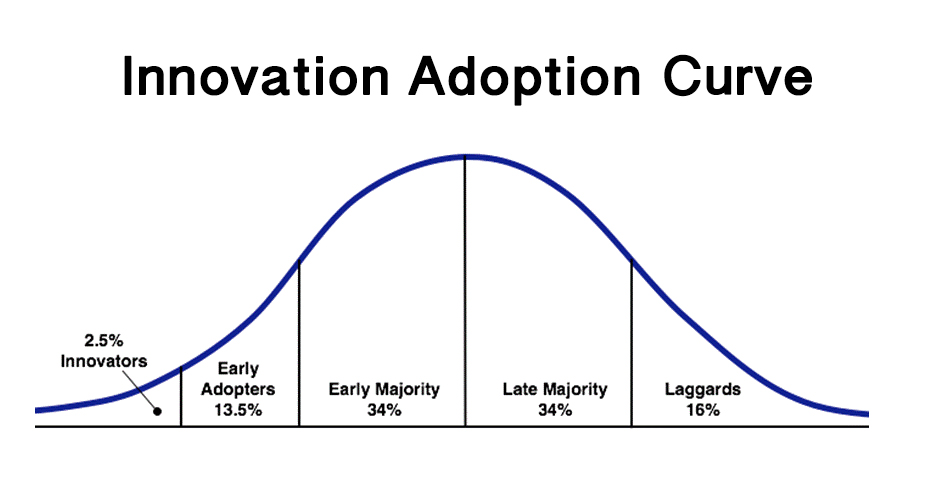Despite the highs and lows of blockchain and cryptocurrencies in 2017/18, there’s simply too much to ignore from this technology that will act as a leader of digital transformation over the next few years. In 2017, we saw heavy cryptocurrency adoption, followed by an 80% decline in the price of Bitcoin during 2018 (with altcoins affected even more in many cases). As a digital product company, however, we’re much more concerned with blockchain technology and its adoption (as opposed to cryptocurrencies, which I’m still rather skeptical about). Looking at a standard innovation adoption curve (copied below), we’re very much in the innovation/early adoption stage of blockchain. Despite many having been eager to leverage from the rapid growth of cryptocurrencies, the use of blockchain technology commercially is still miniscule. Many organisations are undergoing research and development, but few have released products using the technology.
Let’s start by recapping on announcements from 2018, before plugging away at our expectations of 2019 and how you can be best equipped (or if you just need to know the latter, scroll to the end of this article). Note that while we recognise the international efforts being committed to blockchain, these stories are focussed on Australian blockchain projects.
Australian Government Budget
The Australian Government announced in their Federal Budget that a portion would be allocated to blockchain research and development. An excerpt from the 2018/2019 Federal Budget expressed that “The Government will provide $0.7 million in 2018-19 for the Digital Transformation Agency to investigate areas where blockchain technology could offer the most value for Government services.” A further $200,000 has been provided for the advancement of standards (presumably ISO or similar based on recent government appearances).
University of Sydney
The University of Sydney signed a partnership to compete with the likes of Ethereum and EOS. If you’re unfamiliar, these are two of the largest public blockchain networks presently available, so taking them on is a huge feat in itself. The network called Fantom was established in South Korea raising AU $55 million in its initial coin offering (ICO) in June 2018. The University of Sydney intends on enabling their students by building within the Fantom network, presumably as part of a much larger blockchain research and development effort.
Commonwealth Bank
The Commonwealth Bank of Australia (CBA) announced in July that they are using the Ethereum network to export fresh food overseas. In August, they were chosen by the World Bank to deliver the world’s first blockchain bond (read more here). That said, CBA’s CFO left the bank in May 2018 taking an executive role at the company behind the EOS network.
ASX
The Australian Stock Exchange (ASX) is struggling with their blockchain project which intends to replace the legacy CHESS system. In April (only 6 months into the project) their scheduled launch date was altered from September 2020 to March 2021. This may seem insignificant, but for a technology that is extremely new, a substantial degree of development is likely to occur in this period. Speed to market is essential. If this wasn’t enough, in December 2018 the high profile CEO of the project (Blythe Masters) announced her resignation from the ASX’s primary tech partner (Digital Asset Holdings). Tim Hogben, COO of the ASX expressed that the exchange “was outpacing global peers in opening up its data for customers and startups”, which would all be fine…if it were actually true. Tim Hogben’s statement was released on 16 September 2018 and we’re still waiting.
Power Ledger
Power Ledger has been making waves with high profile individuals such as Sir Richard Branson. In 2018, they won the Extreme Tech Challenge, impressing a panel including Branson. Power Ledger expressed within a Medium post “to say we are thrilled to be crowned winners…is an understatement.” The team here at Station Five consequently reached out to our solar energy consultant, who expressed the architecture proposed by Power Ledger is not well thought out, with the team not holding the credentials required to pull together such a large scale project. That said, they’ve certainly identified and successfully executed the notion that having a high profile team of executives who can sell to investors is enough to build a business. Now they just need to follow through with their product.
Cryptocurrency Scams
The Australian Taxation Office (ATO) has issued a number of warnings pertaining to cryptocurrency related scams. In March 2018, the ATO issued an urgent warning pertaining to a Bitcoin tax scam (see here). Fraudsters were impersonating the ATO, demanding cryptocurrency for payment of illegitimate tax debts. This is no surprise, with cryptocurrencies used so heavily to conduct criminal activity (it was built for the Deep Web, so I’m unsure why this is a surprise to Assistant Commissioner Kath Anderson). Furthermore, ASIC is starting to crack down on initial coin offerings and their promoters (finally). You can read more about this here and here.
Implementing blockchain in 2019
Implementing blockchain this year will offer a number of challenges. As an emerging technology, the research required is significant. There are a number of short tips to take with you when implementing blockchain technology:
- Follow patterns from existing technologies: Be careful to use digital principles inspired by existing technologies. In other words, use what we already know about technology to approach blockchain related problems. Blockchain was inspired by existing technologies, and history always repeats itself, so structure your project accordingly.
- Seek help from the open source community: The blockchain community is very public and very helpful. They’re always eager to assist others and grow together. Being involved with the right groups of people can really foster mutual growth and success. Remember to always give back to the community.
- Learn from the blockchain: Blockchain may not be for everyone, but it does offer ideas around cybersecurity that can be adopted in other applications.
- Approach with the MVP mindset: Approaching a blockchain project with the minimum viable product mindset (create only what is essential first) will enable an iterative process that attracts a more successful delivery through iteration.
It’s also worth asking yourself before any blockchain project whether you need the blockchain to conduct your desired operations, or whether you’re attempting to utilise the technology to gather attention from your audience. Always ensure you use it for the right reasons, as it will pose greater costs and time to delivery if implemented.
Risks of blockchain implementation
As an immature technology, blockchain implementation brings two major risks. Firstly, with so many advancements since blockchain’s inception, hackers have found a number of vulnerabilities that have caused huge financial losses. The financial losses were naturally caused by networks using cryptocurrencies. However, this does pose a threat to organisations using blockchain for purposes other than cryptocurrencies. Previous blockchain related issues have been capable of emulating false transactions on the blockchain, a platform that is intended to reassure users based on data integrity. Hackers implementing false transactional data creates a huge threat, particularly in the case of banking and financial implementations. The largest threat to blockchain however is quantum computing. Despite largely theoretical presently (although being heavily researched), computer scientists forecast that quantum computing will deem blockchain obsolete. You can read more about the technical issues here. However, in short, quantum computing will theoretically be capable of cracking the high level of security offered by blockchain technology. In short, using private blockchain networks is a workaround here, with public networks (such as Ethereum and EOS) being the highest risks.
If you want to learn more about blockchain and how to best implement the new technology in 2019, stay tuned. We’ll be publishing a number of more specific implementation strategies over the weeks ahead.




